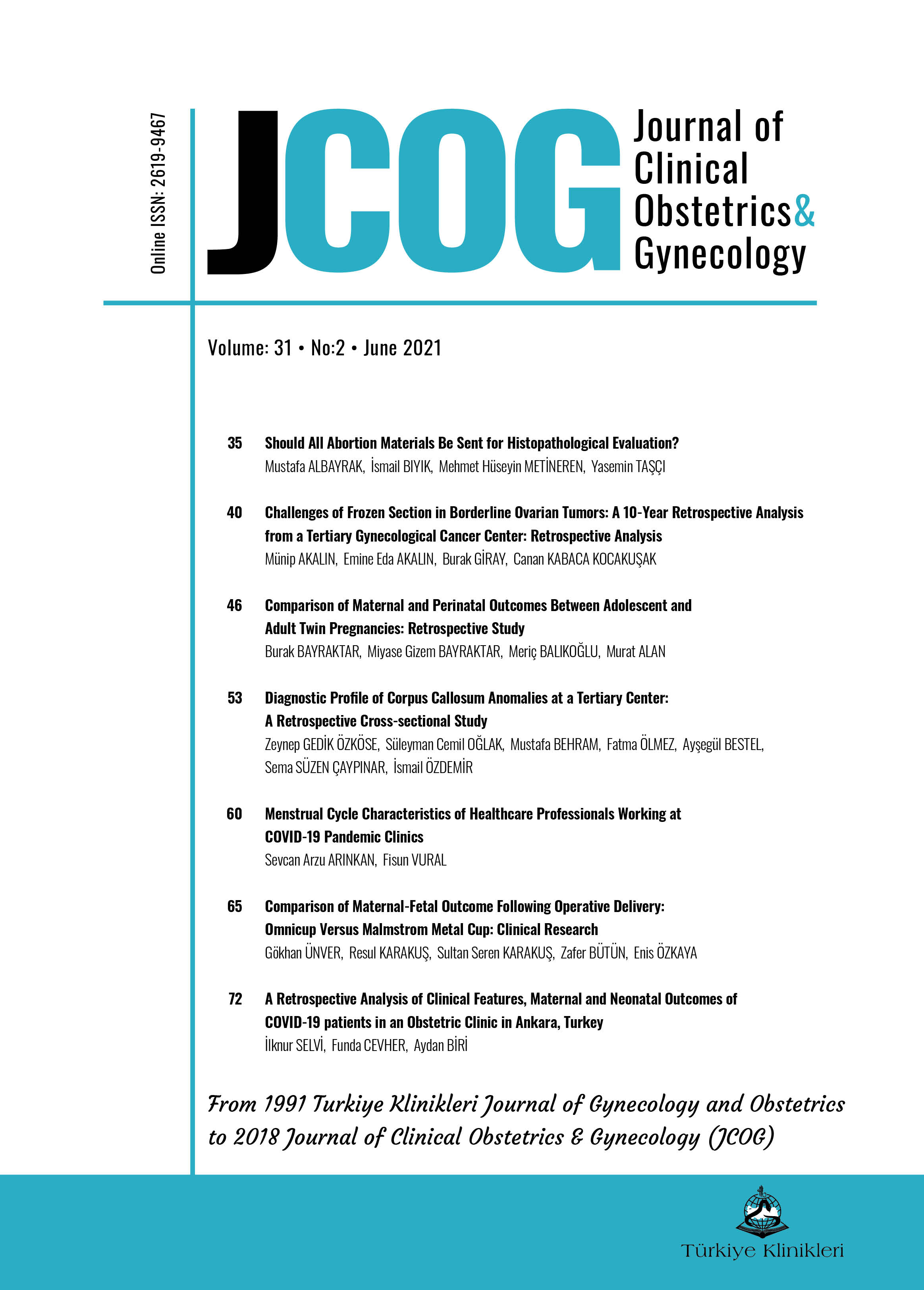Open Access
Peer Reviewed
ORIGINAL RESEARCH
2355 Viewed1601 Downloaded
Comparison of Maternal-Fetal Outcome Following Operative Delivery: Omnicup Versus Malmstrom Metal Cup: Clinical Research
Received: 08 Feb 2021 | Received in revised form: 02 May 2021
Accepted: 04 May 2021 | Available online: 05 May 2021
J Clin Obstet Gynecol. 2021;31(2):65-71
DOI: 10.5336/jcog.2021-82080
Article Language: EN
Article Language: EN
Copyright Ⓒ 2025 by Türkiye Klinikleri. This is an open access article under the CC BY-NC-ND license (http://creativecommons.org/licenses/by-nc-nd/4.0/)
ABSTRACT
Objective: To compare the success, clinical outcomes, maternal and neonatal complication rates following Kiwi Omnicup or the Malmstrom metal cup in vacuum assisted delivery. Material and Methods: One hundred eighty eight vaginal deliveries which were achieved by the use of Kiwi Omnicup or the Malmstrom metal cup in Zeynep Kamil Women's Health Training and Research Hospital between January 2008 to March 2015 were screened from prospectively collected database. All cases were singleton, viable pregnancies with cephalic presentation. Groups were compared in terms of some maternal and fetal complications and morbidities including cephal hematoma, caput succadanum, hemorrhagic ischemic encephalopathy, molding, acidosis, hypothonia, shoulder distocia, meconium passage, maternal vaginal lacerations, blood hematoma, rib fructure, cervical laceration, 3rd and 4th degree lacerations and the uterine atonia. Results: Fetal complications were significantly different between groups. The rate of cephal hematoma was significantly higher in Malmstrom metal cup whereas the rate of fetal acidosis was significantly higher in group with Kiwi Omnicup (p
Objective: To compare the success, clinical outcomes, maternal and neonatal complication rates following Kiwi Omnicup or the Malmstrom metal cup in vacuum assisted delivery. Material and Methods: One hundred eighty eight vaginal deliveries which were achieved by the use of Kiwi Omnicup or the Malmstrom metal cup in Zeynep Kamil Women's Health Training and Research Hospital between January 2008 to March 2015 were screened from prospectively collected database. All cases were singleton, viable pregnancies with cephalic presentation. Groups were compared in terms of some maternal and fetal complications and morbidities including cephal hematoma, caput succadanum, hemorrhagic ischemic encephalopathy, molding, acidosis, hypothonia, shoulder distocia, meconium passage, maternal vaginal lacerations, blood hematoma, rib fructure, cervical laceration, 3rd and 4th degree lacerations and the uterine atonia. Results: Fetal complications were significantly different between groups. The rate of cephal hematoma was significantly higher in Malmstrom metal cup whereas the rate of fetal acidosis was significantly higher in group with Kiwi Omnicup (p
REFERENCES:
- Martin JA, Hamilton BE, Sutton PD, Ventura SJ, Menacker F, Kirmeyer S, et al; Centers for Disease Control and Prevention National Center for Health Statistics National Vital Statistics System. Births: final data for 2005. Natl Vital Stat Rep. 2007;56(6):1-103. [PubMed]
- Clark SL, Belfort MA, Hankins GD, Meyers JA, Houser FM. Variation in the rates of operative delivery in the United States. Am J Obstet Gynecol. 2007;196(6):526.e1-5. [Crossref] [PubMed]
- Kozak LJ, Weeks JD. U.S. trends in obstetric procedures, 1990-2000. Birth. 2002;29(3):157-61. [Crossref] [PubMed]
- Operative Vaginal Birth: ACOG Practice Bulletin, Number 219. Obstet Gynecol. 2020; 135(4):e149-e159. [Crossref] [PubMed]
- Bofill JA, Rust OA, Schorr SJ, Brown RC, Martin RW, Martin JN Jr, et al. A randomized prospective trial of the obstetric forceps versus the M-cup vacuum extractor. Am J Obstet Gynecol. 1996;175(5):1325-30. [Crossref] [PubMed]
- Groom KM, Jones BA, Miller N, Paterson-Brown S. A prospective randomised controlled trial of the Kiwi Omnicup versus conventional ventouse cups for vacuum-assisted vaginal delivery. BJOG. 2006;113(2):183-9. [Crossref] [PubMed]
- Equy V, David-Tchouda S, Dreyfus M, Riethmuller D, Vendittelli F, Cabaud V, et al. Clinical impact of the disposable ventouse iCup® versus a metallic vacuum cup: a multicenter randomized controlled trial. BMC Pregnancy Childbirth. 2015;15:332. [Crossref] [PubMed] [PMC]
- Vacca A. A randomised controlled trial of a new handheld vacuum extraction device. BJOG. 2006;113(4):492; author reply 494-5. [Crossref] [PubMed]
- Dell DL, Sightler SE, Plauché WC. Soft cup vacuum extraction: a comparison of outlet delivery. Obstet Gynecol. 1985;66(5):624-8. [PubMed]
- Ali UA, Norwitz ER. Vacuum-assisted vaginal delivery. Rev Obstet Gynecol. 2009;2(1):5-17. [PubMed] [PMC]
- O'Mahony F, Hofmeyr GJ, Menon V. Choice of instruments for assisted vaginal delivery. Cochrane Database Syst Rev. 2010;(11): CD005455. [Crossref] [PubMed]
- Salamalekis E, Vitoratos N, Loghis C. Vacuum extraction for operative vaginal delivery. Int J Gynaecol Obstet. 1998;63(2):185-7. [Crossref] [PubMed]
- Johanson R, Menon V. Soft versus rigid vacuum extractor cups for assisted vaginal delivery. Cochrane Database Syst Rev. 2000(2):CD000446. Update in: Cochrane Database Syst Rev. 2010;(11):CD000446. [Crossref] [PubMed]
- Bird GC. The importance of flexion in vacuum extractor delivery. Br J Obstet Gynaecol. 1976;83(3):194-200. [Crossref] [PubMed]
- Ismail NA, Saharan WS, Zaleha MA, Jaafar R, Muhammad JA, Razi ZR. Kiwi Omnicup versus Malmstrom metal cup in vacuum assisted delivery: a randomized comparative trial. J Obstet Gynaecol Res. 2008;34(3):350-3. [Crossref] [PubMed]
- Angioli R, Gómez-Marín O, Cantuaria G, O'sullivan MJ. Severe perineal lacerations during vaginal delivery: the University of Miami experience. Am J Obstet Gynecol. 2000; 182(5):1083-5. [Crossref] [PubMed]
- Weissbach T, Hag-Yahia N, Ovadia M, Tzadikevitch Geffen K, Weitzner O, Biron-Shental T. Kiwi OmniCup Handheld vs. Mityvac M-Style Conventional Vacuum System: a retrospective observational study. J Matern Fetal Neonatal Med. 2017:1-8. [Crossref] [PubMed]
- González-Diaz E, García-Mejido JA, Martín-Martínez A, Fernández-Fernández C, Ortega I, Medina M, et al. Are there differences in the damage to the pelvic floor between malmstrom's and kiwi omnicup vacuums? A multicenter study. Neurourol Urodyn. 2020;39(1): 190-6. [Crossref] [PubMed]
- Turkmen S. Maternal and neonatal outcomes in vacuum-assisted delivery with the Kiwi OmniCup and Malmström metal cup. J Obstet Gynaecol Res. 2015;41(2):207-13. [Crossref] [PubMed]
MENU
POPULAR ARTICLES
MOST DOWNLOADED ARTICLES





This journal is licensed under a Creative Commons Attribution-NonCommercial-NoDerivatives 4.0 International License.










